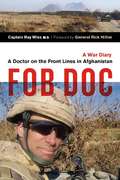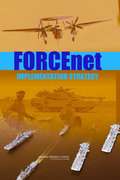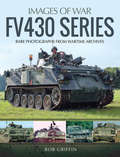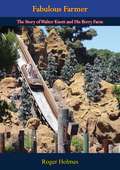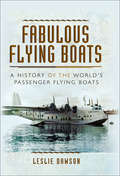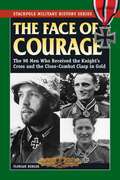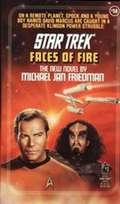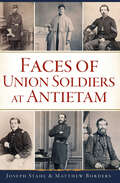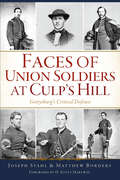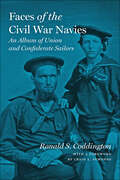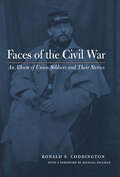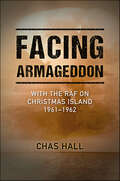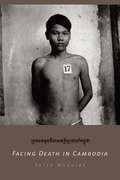- Table View
- List View
FOB Doc
by Ray WissMilitary doctors serving in Afghanistan usually spend their entire tour in the relatively safe confines of the main base. FOB Doc is the story of one Canadian doctor who spent nearly his entire tour in combat. Captain Ray Wiss was stationed at Forward Operating Bases - FOBs - in Khandahar province, the birthplace of the Taliban and the most intense zone combat in Afghanistan. He shares the 'terror and boredom' of the front-line soldier's life in this candid personal diary. One day, he might be participating in combat operations, treating severe and bloody injuries and coping with the deaths of fellow soldiers, both Afghans and NATO allies; another day, he might be writing about the challenges of going to the latrine in sub-zero weather. FOB Doc is heartbreaking and hilarious, often on the same page.
FORCEnet: IMPLEMENTATION STRATEGY
by National Research Council of the National AcademiesThe National Academies Press (NAP)--publisher for the National Academies--publishes more than 200 books a year offering the most authoritative views, definitive information, and groundbreaking recommendations on a wide range of topics in science, engineering, and health. Our books are unique in that they are authored by the nation's leading experts in every scientific field.
FRISCO'S KID: Frisco's Kid Everyday, Average Jones (Tall, Dark and Dangerous #3)
by Suzanne BrockmannNew York Times and USA TODAY bestselling author Suzanne Brockmann has thrilled audiences with her Tall, Dark and Dangerous series. Experience it here with a hero who must face the most daring adventure of all—falling in love.His body may heal, but his heart is another story…Being a Navy SEAL is more than a career to Alan "Frisco" Francisco—it's his whole identity. But when a severe injury threatens Frisco's ability to function in combat, he's determined to achieve a full recovery.But the unexpected appearance of his abandoned niece leaves Frisco with little time for anything but dealing with the five-year-old girl. He knows even less about parenting than he does about how to mend his broken body. And there's no way he's going to accept offers of help from his interfering neighbor, Mia Summerton. He doesn't need anyone s help. Not to care for his niece, not to accept his limitations and certainly not to fall in love.
FUBAR: Soldier Slang of World War II
by Gordon L. RottmanHumorous, sarcastic, sober, pessimistic, fatalistic, defiant or defeatist, slang is an important part of every soldier's vocabulary. Much of the slang of World War II was handed down from World War I and earlier conflicts. These words were so ingrained into the soldier's vocabulary that their use was continued by a new generation of soldiers and by the end of the war some terms had even passed into standard everyday usage. This book is a detailed survey of the slang of WWII as used and evolved by US, German and Commonwealth fighting men and women. It lists hundreds of these distinctive and evocative words with their definitions and origins, but and also includes contemporary cartoons and images, transporting the reader back through the decades into the world of the WWII warrior.
FUEGO A DISCRECION (EBOOK)
by Antonio Dal MasettoLa noche puede ser tan salvaje como lo requiera el alcohol. La lengua suelta, la boca seca, los sentidos confusos. En el umbral, al acecho, el remordimiento. Hasta que, en lugar de salvajes, eufóricas, locas, las noches empiezan a parecer simplemente repetidas. Entonces el que las presencia y las vive tiene que elegir entre las misiones equívocas del aburrimiento y el sacrificio. Fuego a discreción cuenta con aplomado fervor y una ternura exenta por completo de sentimentalismo el tránsito entre una vida que va a consumarse sin conciencia y una especie de resurrección que nos deja a salvo de cualquier exterioridad ingenuamente optimista. Escrita en el crepúsculo de la última dictadura militar, la ciudad de Fuego a discreción es víctima de un verano opresivo que traduce en clave meteorológica la situación política. Patrullas de la policía, operativos del ejército. El capítulo XV precipita una reflexión despiadada sobre la humillación y la tortura. Sin embargo, inexorablemente, se acerca el tiempo de las elecciones. La novela más negra del Tano mantiene con magia narrativa el diurno ritual de la esperanza.
FV430 Series (Images of War)
by Robert GriffinFully illustrated with archival photographs, this volume examines the development of this Cold War era armored vehicle. During the Second World War, the British infantry found itself lacking suitable transport to cope with the fast-moving German Blitzkrieg tactics. While various stopgap measures were implemented during the war, the postwar threats from nuclear, biological and chemical warfare made it imperative that a robust solution be found. By the 1960s, at the height of the Cold War, the AFV430 series was introduced. The FV300 and FV400 Cambridge carriers paved the way for the AFV430. Initially a basic armored personnel carrier, the series grew to cover a multitude of roles, including command, recovery, mortar, Swingfire, and remote mine clearing. This volume of the Images of War series describes in words and images the AFV430 and traces the development of infantry carriers for the British Army.
Fabulous Farmer: The Story of Walter Knott and His Berry Farm
by Paul Bailey Roger HolmesTWENTY MILLION people have walked the acres of Knott’s Berry Farm at Buena Park, California. Its chicken dinners, its wild west atmosphere, its “Ghost Town,” are familiarly known to travellers from every part of the world. Less known, perhaps, is the remarkable story of Walter Knott and his family, who have built their strange enterprise into one of the wonder of the west.Here is the story of how a once penniless sharecropper parlayed ten acres of berries into a farm of golden wonders. How a chicken dinner became a national institution, ad how boysenberries, both in an out of pies, became the means of assembling on hundred acres of historical marvels that have delighted and amused the Farm’s millions of visitors.FABULOUS FARMER is the tale of how one man turned poverty and adversity into dazzling success. It is a story of free American enterprise with odd and new twists. It is an inspiring, human recital of a family whose teamwork, thrift and industry fought through every hardship and crisis until success was theirs. Through its candid, exciting pages breathes the same warmth and friendliness that is so deeply senses by every visitor to the Farm.FABULOUS FARMER is as typically American as Mrs. Knott’s berry pies and fried chicken. It is a joyful, rewarding book that builds courage and faith in its readers, and a book every American will want to read as tonic for his own fears, and antidote for anything that might water down his faith in the future and his belief in himself.
Fabulous Flying Boats: A History of the World's Passenger Flying Boats
by Leslie DawsonThe history of the development and operations of flying boats in the early twentieth century is a vibrant one, full of colourful characters and experimentation. In 'Fabulous Flying Boats', Leslie Dawson captures this spirit of dynamism, reminding us of the most successful early pioneers of the seaplanes development, including a little known and oft-overlooked rival to the Wright Brothers, working to put their mutual successes in context. He goes on to describe, in clear and vivid detail, and using first hand-accounts, what it was like to be aboard one of the resulting huge passenger flying boats, as air crew and as a passenger. He also recounts the part played by the military boats inevitably seconded to such use. Incredibly well researched, the narrative embraces the globe-trotting air routes, from Europe to the Far East and to the Americas, and is well supported with evocative images from private and corporate collections, and the worlds aviation museums. The in-depth Appendix is virtually a book in itself. This book is sure to be a welcome addition to any Aviation enthusiasts library as it covers a particularly important period of Aviation development which formed a fertile environment for a host of young experimenters. The process of development continues to this day.
Fabulous Harbours
by Michael MoorcockAward-winning author Michael Moorcock continuously astonishes readers and critics alike with each new literary offering. Revered for his eloquent, lyrical prose, his work is a testament to the emotional power of words. Fabulous Harbors is the second of a three-book set, and is a bridge between the novels Blood and The War Amongst the Angels. Comprised of 11 interlocking tales, Fabulous Harbors takes the reader by the hand and guides him into and through Moorcock's spectacular expanding multiverse - a luminously realized, richly layered world of fantastic invention and lovingly drawn characters.Here, in the comfort and peace of Sporting Club Square - an obscure and perhaps magical corner of London that seems oddly immune to the normal effects of time - Begg family patriarch Sir Sexton and various family members and friends gather to swap memories, anecdotes and dreams. Come, sit by the fire and listen to the continuing exploits of the brave Sam Oakenhurst, the mysterious and seductive Rose von Bek, old friend and adventure Jerry Cornelius and Elric, the brooding albino prince of ruins, among others.Haunting and compelling, Fabulous Harbors is an extraordinary achievement from a true star in the literary firmament.
Face of Courage (Stackpole Military History Series)
by Florian BergerProfiles of the 98 German soldiers--out of millions--who received both the Knight's Cross (for extreme bravery) and the Close-Combat Clasp in Gold (for at least 50 days of hand-to-hand fighting) during World War II.
Face to Face with Kaiserism (The World At War)
by James GerardJames Watson Gerard (August 25, 1867 – September 6, 1951) was a United States lawyer and diplomat. At the outbreak of World War I in 1914, Gerard assumed the care of British interests in Germany, later visiting the camps where British prisoners were confined and doing much to alleviate their condition. His responsibilities were further increased by the fact that German interests in France, Great Britain, and Russia were placed in the care of the American embassies in those countries, the American embassy in Berlin thus becoming a sort of clearing house. From first-hand knowledge he was able to settle the question, much disputed among the Germans themselves, as to the official attitude of the German government toward the violation of Belgian neutrality. Gerard published two books on his experiences, titled “My Four Years in Germany”, released in 1917 and the following year, “Face to Face with Kaiserism”. (Excerpt from Wikipedia)
Faces of Fire (Star Trek: The Original Series #58)
by Michael Jan FriedmanThe U.S.S. Enterprise™ members must resolve a conflict that could be their demise.En route to Alpha Malurian Six to settle a dispute between two religions, the U.S.S. Enterprise™ first stops to do a routine check on the progress of a terraforming colony on Beta Canzandia Three—a colony whose inhabitants include Carol and David Marcus. While Spock is left behind at the terraforming colony to continue his scientific studies, the rest of the crew heads to Alpha Malurian Six to find the dispute has turned to war. As Kirk, McCoy, and Scotty search for a solution to end the conflict, a ship piloted by a Klingon faction arrives at the terraforming colony to take control of the facility. When colonists are imprisoned, Spock and David must defeat the Klingons or face certain death...
Faces of HMS Royal Oak: The 'Mighty Oak' Disaster at Scapa Flow
by Dilip SarkarOn 14 October each year, a White Ensign is placed on the stern of an upturned warship by Royal Navy divers. This act commemorates the 835 men of HMS Royal Oak who died in 1939 when the battleship was sunk at anchor in Scapa Flow by the German U-boat U-47. The sinking of the veteran First World War Revenge-class Royal Oak shocked not only the Admiralty, but the whole nation. Though Scapa Flow was far from being impregnable as a base for the Royal Navy’s Home Fleet, it was surrounded by a ring of islands separated by shallow channels subject to fast-racing tides. While it was recognized that it was not impervious to enemy submarines, measures had been put in place to minimize any such threat. Blockships had been sunk at potentially vulnerable points and anti-submarine booms deployed across the wider channels. The outbreak of war in September 1939 saw additional anti-submarine measures put in hand. Despite these increased precautions, German aerial reconnaissance had spotted weaknesses which were exploited on the night of 13/14 October 1939, by Kapitänleutnant Günther Prien in U-47. The German submarine was able to slip into Scapa Flow undetected and fire three torpedoes towards Royal Oak. Only one torpedo found its mark. A second salvo was fired and this time all three hit the battleship, igniting a magazine causing massive damage. Within thirteen minutes, HMS Royal Oak had turned over and sank. In Faces of HMS Royal Oak, Dilip Sarkar not only reveals the tragic and moving stories of many of those who died, but also some of the 399 who survived the sinking of the first Royal Navy battleship lost in the Second World War. Through their photographs, and in some cases words, the horrors of those fateful few minutes as Royal Oak rolled and slid into the cold, dark waters of Scapa Flow, are relived in startling clarity.
Faces of Union Soldiers at Antietam (Civil War Series)
by Joseph Stahl Matthew BordersJoin Matthew Borders and Joseph Stahl as they share their expertise and grant glimpses into the lives of those who fought to preserve the Union.The Battle of Antietam, fought near Sharpsburg, Maryland, was the bloodiest day in American history, with more than twenty-three thousand dead, wounded and missing. This book invites the reader to walk the routes of some of the units on the field through the stories of thirty-six individual soldiers who fought on that day. The images of the soldiers in this work, many of which have never been published before, give faces to the fighting men at Antietam, as well as insight into their lives
Faces of Union Soldiers at Culp's Hill: Gettysburg's Critical Defense (Civil War Series)
by Joseph Stahl Matthew BordersThe most pivotal deffensive line in the most pivotal battle in the history of America. The fighting at Culp's Hill during the Battle of Gettysburg was some of the fiercest during the bloody battle, and holding the hill, for the Union, was essential not only for victory in battle, but protecting the country as a whole. Authors Matthew Borders and Joseph Stahl present intimate portraits of twenty-eight soldiers who defended Culp's Hill, including in-depth analysis of never before published images and harrowing accounts of heroism in the fight to save the Union.
Faces of Union Soldiers at Fredericksburg (Civil War Series)
by Matthew BordersLook into the eyes of these soldiers and see the faces of those who dared to stare into the face of Death.The Battle of Fredericksburg, fought December 11-15, 1862, is often remembered for the seemingly futile attacks by the Army of the Potomac against dug in Confederates on Marye's Heights. Less well understood is the fighting south of the heights on what has become known as Slaughter Pen Farm. In this work the images of thirty Union soldiers are published for the first time. They give a face and history to those men who struggled across that bloody landscape, as well as to those that charged up the slope of Marye's Heights into Confederate fire. Authors Matthew Borders and Joseph Stahl introduce you to these men, their stories and their sacrifice on the bullet swept battlefield of Fredericksburg.
Faces of the Civil War Navies: An Album of Human and Confederate Sailors
by Ronald S. CoddingtonExplore the human side of the Civil War through archival images and biographical sketches of Confederate and Union sailors.During the American Civil War, more than one hundred thousand men fought on ships at sea or on one of America’s great inland rivers. There were no large-scale fleet engagements, yet the navies, particularly the Union Navy, did much to define the character of the war and affect its length. The first hostile shots roared from rebel artillery at Charleston Harbor. Along the Mississippi River and other inland waterways across the South, Union gunboats were often the first to arrive in deadly enemy territory. In the Gulf of Mexico and along the Atlantic seaboard, blockaders in blue floated within earshot of gray garrisons that guarded vital ports. And on the open seas, rebel raiders wreaked havoc on civilian shipping.In Faces of the Civil War Navies, Civil War photograph collector Ronald S. Coddington focuses his skills on the Union and Confederate navies. Using identifiable cartes de visite of common sailors on both sides of the war, many of them never before published, Coddington uncovers the personal histories of each individual. These unique narratives are drawn from military and pension records, letters, diaries, period newspapers, and other primary sources. In addition to presenting the personal stories of seventy-seven intrepid volunteers, Coddington also focuses on the momentous naval events that ushered in an era of ironclad ships and other technical innovations.Taken collectively, these “snapshots” show that the history of war is not merely a chronicle of campaigns won and lost, it is the collective personal odysseys of thousands of individual men.
Faces of the Civil War Navies: An Album of Union and Confederate Sailors
by Ronald S. CoddingtonArchival images and biographical sketches of common sailors on both sides of the conflict reveal the human side of the Civil War.During the American Civil War, more than one hundred thousand men fought on ships at sea or on one of America’s great inland rivers. There were no large-scale fleet engagements, yet the navies, particularly the Union Navy, did much to define the character of the war and affect its length. The first hostile shots roared from rebel artillery at Charleston Harbor. Along the Mississippi River and other inland waterways across the South, Union gunboats were often the first to arrive in deadly enemy territory. In the Gulf of Mexico and along the Atlantic seaboard, blockaders in blue floated within earshot of gray garrisons that guarded vital ports. And on the open seas, rebel raiders wreaked havoc on civilian shipping. In Faces of the Civil War Navies, renowned researcher and Civil War photograph collector Ronald S. Coddington focuses his considerable skills on the Union and Confederate navies. Using identifiable cartes de visite of common sailors on both sides of the war, many of them never before published, Coddington uncovers the personal histories of each individual who looked into the eye of the primitive camera. These unique narratives are drawn from military and pension records, letters, diaries, period newspapers, and other primary sources. In addition to presenting the personal stories of seventy-seven intrepid volunteers, Coddington also focuses on the momentous naval events that ushered in an era of ironclad ships and other technical innovations. The fourth volume in Coddington’s series on Civil War soldiers, this microhistory will appeal to anyone with an interest in the Civil War, social history, or photography. The narratives and photographs in Faces of the Civil War Navies shed new light on a lesser-known part of our American story. Taken collectively, these "snapshots" remind us that the history of war is not merely a chronicle of campaigns won and lost, it is the collective personal odysseys of thousands of individual life stories.
Faces of the Civil War: An Album of Union Soldiers and Their Stories
by Ronald S CoddingtonArchival images and biographical sketches of Union soldiers tell the stories of their lives during and after the Civil War.Before leaving to fight in the Civil War, many Union and Confederate soldiers posed for a carte de visite, or visiting card, to give to their families, friends, or sweethearts. Invented in 1854 by a French photographer, the carte de visite was a small photographic print roughly the size of a modern trading card. The format arrived in America on the eve of the Civil War, fueling intense demand for the keepsakes. Many cards of Civil War soldiers survive today, but the experiences?and often the names?of the individuals portrayed have been lost to time. A passionate collector of Civil War–era photography, Ron Coddington researched the history behind these anonymous faces in military records, pension files, and other public and personal documents.In Faces of the Civil War, Coddington presents 77 cartes de visite of Union soldiers from his collection and tells the stories of their lives during and after the war. These soldiers came from all walks of life. All were volunteers. Their personal stories reveal a tremendous diversity in their experience of war: many served with distinction, some were captured, some never saw combat while others saw little else. The lives of survivors were even more disparate. While some made successful transitions back to civilian life, others suffered permanent physical and mental disabilities, which too often wrecked their families and careers. In compelling words and haunting pictures, Faces of the Civil War offers a unique perspective on the most dramatic and wrenching period in American history.
Faces of the Confederacy: An Album of Southern Soldiers and Their Stories
by Ronald S. Coddington“Extensive research, fascinating characters . . . The author has done an admirable job of literally placing a face on the ordinary Confederate soldier.” —The Journal of Southern History“The history of the Civil War is the stories of its soldiers,” writes Ronald S. Coddington in the preface to Faces of the Confederacy. This book tells the stories of seventy-seven Southern soldiers—young farm boys, wealthy plantation owners, intellectual elites, uneducated poor—who posed for photographic portraits, cartes de visite, to leave with family, friends, and sweethearts before going off to war. Coddington, a passionate collector of Civil War-era photography, conducted a monumental search for these previously unpublished portrait cards, then unearthed the personal stories of their subjects, putting a human face on a war rife with inhuman atrocities.The Civil War took the lives of twenty-two of every hundred men who served. Coddington follows the exhausted survivors as they return home to occupied cities and towns, ravaged farmlands, a destabilized economy, and a social order in the midst of upheaval. This book is a haunting and moving tribute to those brave men.Like its companion volume, Faces of the Civil War: An Album of Union Soldiers and Their Stories, this book offers readers a unique perspective on the war and contributes to a better understanding of the role of the common soldier.“With his meticulous research and a journalist’s eye for good stories, Ron Coddington has brought new life to Civil War photographic portraits of obscure and long-forgotten Confederates whose wartime experiences might otherwise have been lost to history.” —Bob Zeller, cofounder and president of the nonprofit Center for Civil War Photography
Faces of the Few: The Battle for Survival in the Summer of 1940
by Dilip SarkarThere remains an enduring fascination with the Battle of Britain, and the RAF aircrew who fought and won this unprecedented aerial conflict, immortalized by Churchill in August 1940 as ‘The Few’. Unlike today, when photography is a huge part of people’s daily lives, not least because of mobile phone cameras and the sharing of images via social media, back then photography involved comparatively primitive and expensive items of equipment and was not, therefore, as accessible as it is today. Furthermore, unofficial photography on service installations in Britain was strictly prohibited for security reasons, and consequently such photographs, often taken surreptitiously, are comparatively rare (although, interestingly, amateur photography was much more popular in Germany, and German servicemen took countless photographs, especially during the Blitzkrieg years). The author’s personal relationships and friendships with many of The Few, however, enabled him to unlock their personal archives, photograph albums and personal snapshots. The result of this research represents a substantial and unique archive. These photographs are not, in the main, posed official pictures, but those snapped by air and groundcrews who were keen amateur photographers, their images often shared around their squadron mates. The photographs presented here, some for the first time, provide the reader with a fascinating window on the past, through which we get an authentic glimpse of the summer of 1940 and The Few themselves. Indeed, in some cases, these are the only known images of certain individuals, while the likeness of others has been lost to history. That fact, therefore, emphasizes the importance of this photographic record.
Facing Armageddon: With the RAF on Christmas Island 1961–1962
by Chas Hall"...a worthy addition to a little-known aspect of British military history." — Flypast After being called up for National Service in July 1960, twenty-year-old Chas Hall joined the RAF and signed on to extend his time for an extra three years becoming a regular serviceman. Following initial training, he became a wireless operator and served at RAF Mildenhall. It was shortly after this that he got his first foreign posting in late 1961 to Christmas Island. It was on this island, that Chas encountered the horrors of nuclear testing. In an operation codenamed ‘Brigadoon’ by the British government and ‘Dominic’ by the Americans, Chas experienced 25 atmospheric nuclear tests. This he describes as his ‘12-month sentence’ alongside over 300 British and 10,000 American servicemen who were posted to one corner of a remote coral island. Facing Armageddon reveals the true extent of the controversial nuclear testing and how it affected servicemen; with 25 men dying during Chas’s time on Christmas Island and many more suffering mentally as they continued serving on the island. With the British government announcing medals for nuclear test veterans in November 2022 to recognize their contribution in the tests after a four-year campaign by participants and The Mirror newspaper, Chas’s story gives insight to why these servicemen deserve the recognition for their part in these tests. This book will contain a number of unpublished photos from the author’s personal collection and is an essential piece of work in understanding the tough conditions servicemen faced during their time on Christmas Island.
Facing Death in Cambodia
by Peter MaguireThis book is the story of Peter Maguire's effort to learn how Cambodia's "culture of impunity" developed, why it persists, and the failures of the "international community" to confront the Cambodian genocide. Written from a personal and historical perspective, Facing Death in Cambodia recounts Maguire's growing anguish over the gap between theories of universal justice and political realities. Maguire documents the atrocities and the aftermath through personal interviews with victims and perpetrators, discussions with international officials, journalistic accounts, and government sources.
Facing Death in Cambodia
by Peter MaguireThe Khmer Rouge regime took control of Cambodia by force of arms, then committed the most brazen crimes since the Third Reich: at least 1.5 million people murdered between 1975 and 1979. Yet no individuals were ever tried or punished. This book is the story of Peter Maguire's effort to learn how Cambodia's "culture of impunity" developed, why it persists, and the failures of the "international community" to confront the Cambodian genocide. Written from a personal and historical perspective, Facing Death in Cambodia recounts Maguire's growing anguish over the gap between theories of universal justice and political realities.Maguire documents the atrocities and the aftermath through personal interviews with victims and perpetrators, discussions with international and NGO officials, journalistic accounts, and government sources gathered during a ten-year odyssey in search of answers. The book includes a selection of haunting pictures from among the thousands taken at the now infamous Tuol Sleng prison (also referred to as S-21), through which at least 14,000 men, women, and children passed—and from which fewer than a dozen emerged alive.What he discovered raises troubling questions: Was the Cambodian genocide a preview of the genocidal civil wars that would follow in the wake of the Cold War? Is international justice an attainable idea or a fiction superimposed over an unbearably dark reality? Did issues of political expediency allow Cambodian leaders to escape prosecution?The Khmer Rouge violated the Nuremberg Principles, the United Nations Charter, the laws of war, and the UN Genocide Convention. Yet in the decade after the regime's collapse, the perpetrators were rescued and rehabilitated-even rewarded-by China, Thailand, the United States, and the UN. According to Peter Maguire, Cambodia holds the key to understanding why recent UN interventions throughout the world have failed to prevent atrocities and to enforce treaties.
